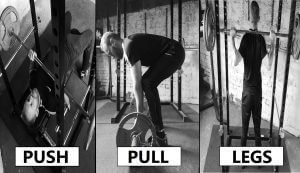These articles are for anyone looking to start lifting weights for the first time. They’re also suitable for someone wanting to switch to a new workout program. With a basic understanding of the gym every program you read will make more sense and you’ll be more confident getting started.
Where To Start
The first thing you need to think about is how many times a week you can exercise. You can absolutely get in better shape from just one workout a week, that’s especially true if you’ve previously been doing.. zero.. workouts a week. Ideally though, you’d aim for something in the range of 2 to 5 sessions a week.
How many workouts or sessions you do in a week will dictate what you get up to in each session, and you’ll see why in a minute. In general people are going to break up each visit to the gym based on what muscle groups they are training, so before we continue we need a really quick anatomy lesson. When I mention specific muscle groups it’s going to help you to know where they are on the body.
Upper Body Anatomy
Let’s start with the upper body, which is everything above the waist. You should be familiar with shoulders, their technical name is the deltoids but most gym-goers will call it a “shoulder workout”. Then the arms, you have the biceps on the front of the upper arm and the triceps on the back of the arm.
- A bi-cycle has two wheels and your bi-ceps have two heads (separate muscles).
- A tri-cycle has three wheels and your tri-ceps have three heads.
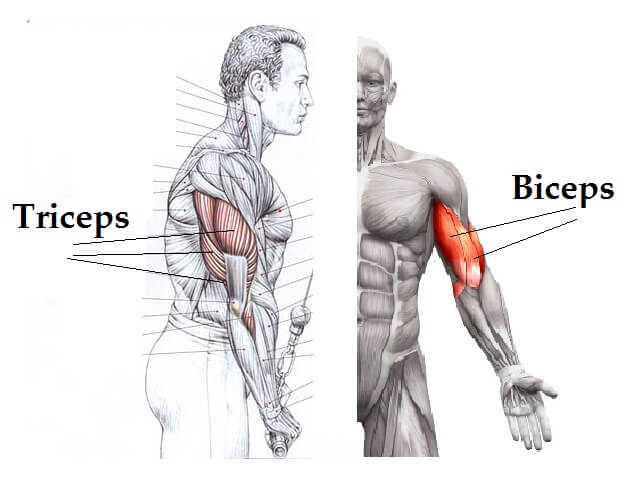
Your back has quite a few individual muscles but people would simply say they’re doing a “back workout”. The same goes for the chest, there’s upper and lower but generally all in the same workout. Finally the abs or core, which isn’t just the six pack muscles but don’t worry about that.
Lower Body Anatomy
The lower body is easier. People who go to the gym will say they are training “legs”, but we’ll break it down a bit.
- Down the back of your body you have the glutes, your bum muscles.
- Below that your hamstrings on the back of the thigh.
- Further down are your calves on the lower leg.
- On the front of your thigh are your quadriceps or quads. Bi-ceps have two muscles, tri-ceps have three muscles, and your quad-riceps have.. four muscles. Note that one (vastus intermedius) is underneath the others so on the surface you will only see three of them.
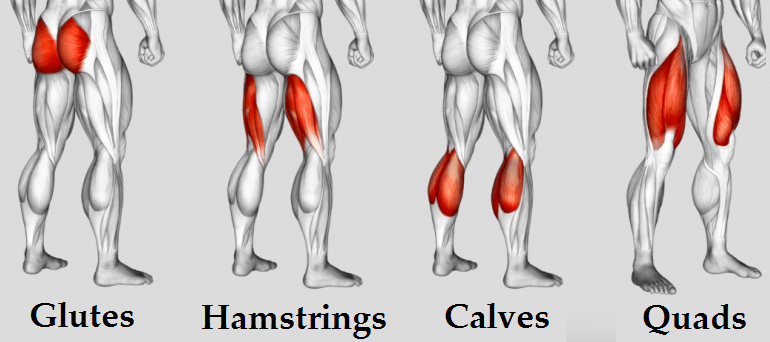
In an ideal world you would train all your muscles, but some people are only interested in a few muscle groups. For example my mum only wants stronger legs, and a few of my friends are only interested in training their arms. While it’s better to train everything, something is better than nothing, and if it gets you lifting weights it’s fine by me.
To help you see how to break up your training by muscle groups I’m going to start by showing you how a bodybuilder trains. Once you understand that you’ll see how it relates to other ways of training.
Bodybuilding Split
How you divide up your sessions in a week is called your training split, because you are splitting up your training. A common bodybuilding split might look like this, training four days a week.
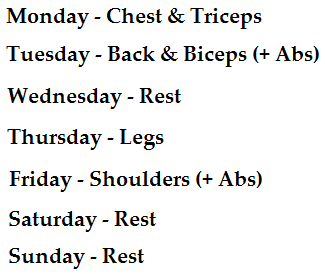
There are two things to note here: Firstly, thinking about the muscles we mentioned earlier you can match them up and see we train everything but abs once in a week. Abs are put at the end of a session because they’re a central part of the body and used a lot in stability. By exercising them you’re tiring them, possibly making certain exercises unstable and therefore unsafe. If I’m doing a squat with weight on my back, or lifting something overhead, I don’t want a tired mid-section that can’t support what I’m doing. That’s why a second consideration is what you’re doing the next day. You wouldn’t want to train abs on the Wednesday, because the day after exercise the muscles tend to be tired and sore, so that would mean compromising your leg session. When you’re planning your workouts, put abs at the end.
Secondly, let’s look at how Monday and Tuesday are grouped. Chest exercises tend to involve a lot of pressing or pushing movements, where you’re moving weight away from your body. An example of this is the bench press. The muscles that assist with a lot of pushing movements are the triceps, on the back of the arms. For the same reason you don’t want to do abs just before a heavy squat, you don’t want to exercise your triceps the day before you train chest. It would mean having tired and sore arms that weren’t as good at things like bench press, so you wouldn’t lift as much weight and you’d limit how effective the workout can be.

Back exercises are the opposite and require a lot of pulling movements, bringing something towards your body. The weight can move, like a rowing movement, or you can move, like in a chin up or inverted row. Just like the triceps help to push, the biceps help to pull. As they are both active for a lot of the same movements, it makes sense to train your back and your biceps in the same workout. For the same reason your chest and triceps can be grouped into another workout.
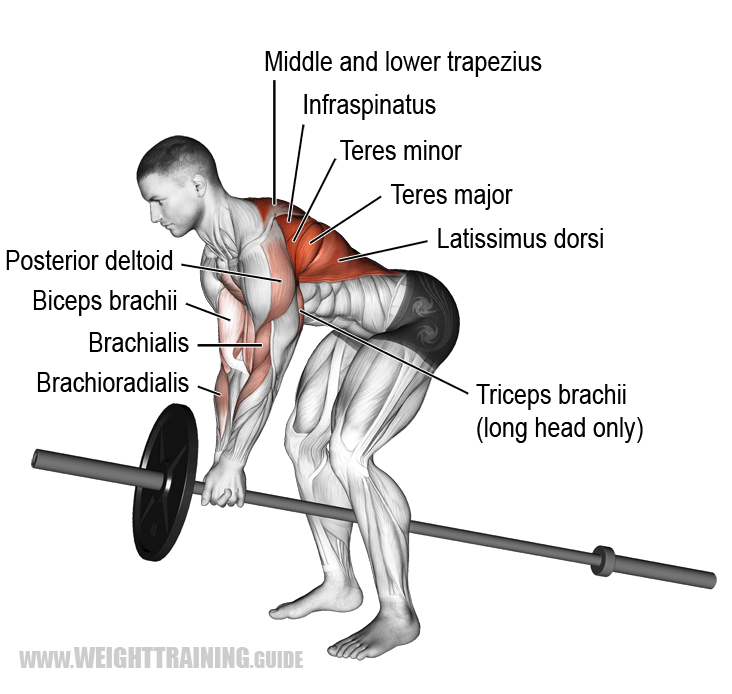
Push/Pull/Legs Split
So that’s a bodybuilding split, and that’s one way to break up your training into four sessions a week. Next I’m going to show you another popular routine, called Push/Pull/Legs (aka PPL routine).
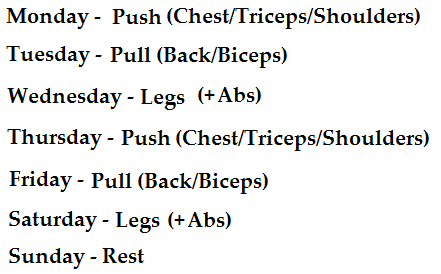
This is actually very similar to the bodybuilding split, except shoulders are grouped with chest and triceps. That’s going to be called the Push day, where you do pushing movements. Tuesday stays the same but it gets called the Pull day, so it’s full of pulling movements. Legs are trained on the Wednesday, before the sessions are repeated for a total of six workouts in a week. Some people prefer to train legs once a week, so you have the potential to turn Wednesday or Saturday into a rest day, but that’s how Push/Pull/Legs routine would look. Abs are nice before a day off so they could go on Saturday, then maybe Wednesday too.

Upper/Lower Body Split
Going one stage further, we’re going to use that nice dividing line at the waist, and each workout will either be Upper Body or Lower Body.
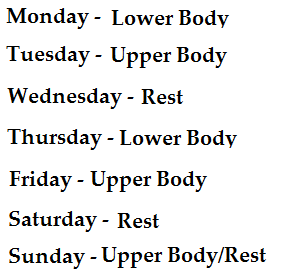
That means for Upper Body all your pushing and pulling movements get grouped together. A common rule is that your legs take three to four days to recover from heavy lifting, so most people won’t train them more than twice in a week. Your upper body can be good to go in 48 hours, so Sunday can be a third session if desired.
Full Body Split
You might be able to guess the final variation, which is just Full Body.
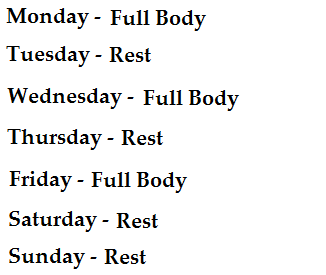
With Full Body you train everything in one go. This could be two or three sessions over a week, preferably three. Unlike other splits, you can get away with training legs three times a week in a set up like this. That’s because you can’t do as many exercises for each body part without spending all day in the gym. Instead of three leg exercises twice a week, you might do two leg exercises, three times a week. The same goes for pushing and pulling exercises in order to avoid spending more than ~90 minutes in the gym.
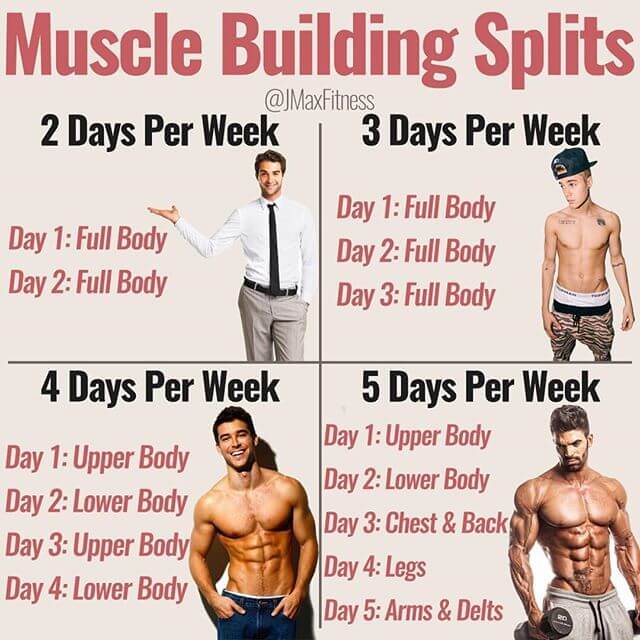
A quick note on the image above: when you see a program that mentions Day 1, Day 2 and Day 3, those are not necessarily consecutive days. In the case of the three days per week split, they simply indicate training frequency in a given week. You should aim to space the sessions out to suit you. It doesn’t have to be Monday, Wednesday, Friday, any days are fine if you allow at least one day rest between sessions.
Summary
So here’s a quick summary of the workout programs we’ve looked at, in reverse order:
- We have the Full Body split, where you train all muscle groups every time you go to the gym. This can be done two or three times a week. As there’s so much to get through you’re probably choosing one or two exercises for each body part.
- Next we have the Upper/Lower split. I like this one because most exercises fall nicely into one category, the main exception being deadlifts. Some people call deadlifts a leg exercise and others label them a back exercise. All your pushing and pulling upper body movements are on one day, and legs are on another. You can either do two sessions of each, or three upper body and 2 lower body. It’s best not to put the same session on consecutive days. That’s because the upper body needs about 48 hours recovery, and the lower body needs 72 hours.
- Breaking it up further we have Push/Pull/Legs, ideally repeated twice in a week meaning six sessions. There is the option to drop that second leg session and make it a five day workout.
- Finally something more like a bodybuilding split, where shoulders get their own day. Below is the training split from the book Bigger, Leaner, Stronger. Remember chest exercises often use the triceps, and back exercises often use the biceps, so you can imagine those appearing on Monday and Tuesday. The upper body day on Saturday could be reserved for what you feel are weak areas that need more attention. Maybe your chest needs extra work or you just want a day of biceps and triceps for big arms.
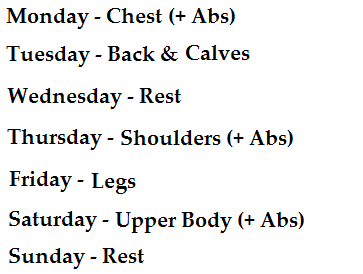
In the next article I’ll go through some of the most popular pre-made workout programs that a lot of gym-goers will follow.

